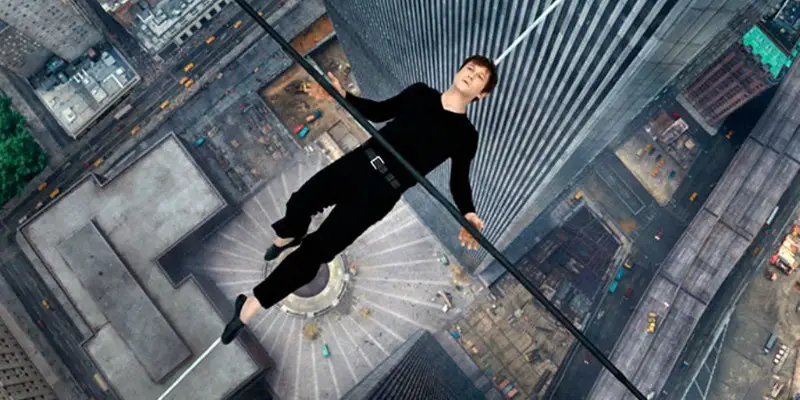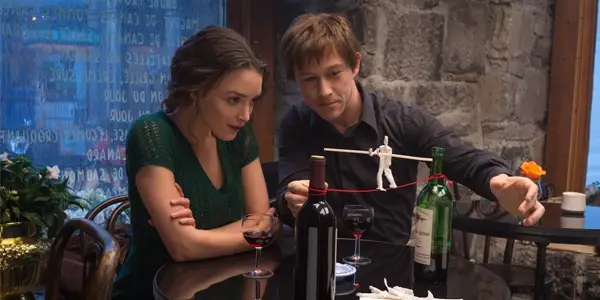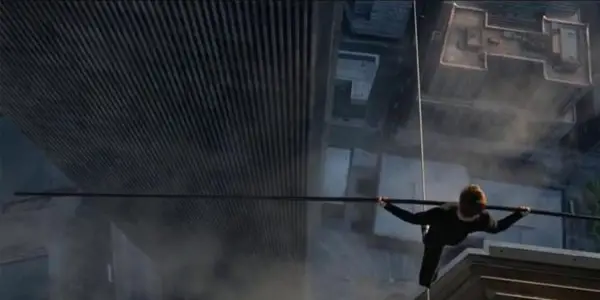THE WALK: Balancing the Line Between Schmaltz and Schlock

Alex is a 28 year-old West Australian who has a…
Remember when 3D movies dominated our cinematic landscape? No, not the 1980’s, where blurry red and blue glasses gave way to gimmicky horror films such as Jaws 3D and Amityville 3D. I’m also not talking about the early 2000’s, where 3D was turned over to children’s films, producing flops like Spy Kids 3 and The Polar Express. The point I’m talking about was the dark (and dimly-lit) ages of 2009 – 2013, a post Avatar era where a billion dollar film produced fool’s gold in the streets of Hollywood, having every studio pump their already bloated mainstream fare with post-converted 3D, pulling pennies from the pockets of those gullible enough to keep giving into the short-term passing.
Studios failed to realize it was Avatar the movie itself that was the phenomenon (one which has gone the way of the dodo) not the 3D effect it dragged back into cinema. Clash of the Titans, Shrek, Resident Evil and more were given the 3D treatment, till a sharp decline in financial return saw the trend slowly fade away, now only given to the occasional blockbuster (Marvel do it for every film, with Jurassic World and Mad Max: Fury Road also given pointless 3D versions).
So it felt quite old-fashioned and rather questionable when the marketing for Robert Zemeckis’ The Walk continuously harped on about being an Imax 3D experience, gaining on the appeal that carried Alfonso Cuaron’s Gravity into mainstream success. A 3D event suggests something like a one-off concert, much like a heavily syndicated André Rieu concert or Benedict Cumberbatch performing Shakespeare, not a family-friendly translation of an Oscar winning documentary. Watching the film I can understand why Sony chose to lean so heavily on the 3D aspect of the film, it’s the strongest aspect the film has going for it as a cinematic experience.
From Page To Screen To Screen
In 2008, the documentary Man On Wire was released, which detailed the somewhat forgotten story of French high-wire artist Philippe Petit, a performance artist who in his younger years became obsessed with the idea of walking across the Twin Towers, due to their incredible height and status in the media. Forming his high wire skills for many years on the streets of France, Petit slowly started to build a small entourage, a mix of American and French friends, including his musician girlfriend, who were to aid him in the walk that took over 3 years of planning.

In 1974, he successfully pulled off the walk, going between the towers for over 40 minutes, before police pressure forced him to stop. The crazy story was translated into a heist movie within the Man On Wire documentary, which, paired with Petit’s eccentric personality, made for an entertaining story. The film garnered critical acclaim and a Best Documentary Oscar.
Now Robert Zemeckis, director of such hits as Back to the Future, Forrest Gump and Who Framed Roger Rabbit? has created a narrative based on the documentary. But why? The documentary told the story perfectly and for the most part Zemeckis takes direct scenes, shots and dialogue directly from the documentary, only embellishing smaller plot aspects so as to keep the plot moving. The final 30 minutes, the walk itself, is the one ace up the sleeve that Zemeckis has the entire time, seemingly justifying the film’s existence.
Petit’s walk was never filmed, with only still photographs being taken of the event. The biggest appeal of this film is being able to recreate visually this walk, giving a daunting sense of how dicey the tight-rope walk was, with the 3D adding to the vertigo effect. Joseph Gordon-Levitt plays the Frenchman Petit, delivering a credible French accent that does fall into hokey on occasion. His entrance in the film doesn’t give much promise, with Zemeckis having the film introduced by Gordon-Levitt on an awful green-screen backdrop that shows New York, as he stands on top of the Statue of Liberty.
Whilst the voice-over provided by Gordon-Levitt is fine to truncate plot details and keep the story moving, the film frequently cuts back to the dodgy green-screen which breaks up the film constantly and gives the narrative a weird episodic feeling. Whilst it might seem I’m harping on a minor element, the biggest problem with the film is the entire first act. Zemeckis clearly had the entire ending planned in his head and had to make the rest of the film around that. The first act feels disjointed as the film jumps from Petit’s introduction to a black and white Paris, to another flashback, then finally settling into a colorized Paris, which shows us Petit’s origins.
Our Colourful Cast Of Characters
The first act also introduces us to Papa Rudy, the ambiguous circus leader who becomes an important instructor to Petit. Ben Kingsley, who’s continuing his streak of bizarre casting decisions, dampening his prestigious classier work that he used to perform in, portrays Papa Rudy. His interactions with Petit, which boil down to exposition setups for how wire-walking works, are ridden with predictable tropes of the biopic genre. He is basically a gruff older teacher with the heart of gold who gives valuable life lessons.
The way Papa Rudy’s scenes are shot and the soundtrack used just scream happiness and whimsy, in a ham-fisted way which irritates more than it delights. Another character introduction that is steeped in cliché is that of Petit’s short-lived girlfriend Annie Alix (the delightful Charlotte Le Bon), who is portrayed in a borderline manic-pixie dream girl state due to her innocence and undivided love for Petit and his work. They immediately meet and fall in love, making it feel like she was only included in the script because she existed in real life, rather then because she is a fully fleshed out character.

Once the film hits New York it really starts to hit its stride. The schmaltzy vermeer is shed and the film transitions into a pseudo-heist film, where Petit’s entourage is fleshed out and we get into the fine details of how the walk will be accomplished. The film gains a sense of energy and the supporting cast, who is introduced here, bring the film to life. James Badge Dale really shines as Jean-Pierre, a thrift-store salesman who becomes one of Petit’s key entourage members.
Another enjoyable cast member is Steve Valentine who plays Barry Greenhouse, the staff member at the Twin Towers who allowed the gang entrance into the building. His uncanny resemblance to Jeff Goldblum may confuse some viewers at first, but his eccentric look and endearing personality suggest this is one actor that should be getting more mainstream work. Other members of the group are introduced, but they are barely given much to do, reduced to existing on-screen merely for the sake of replicating what really happened. One of them, an unnamed stoner, leaves the group near the end of the film and no character seems to mind at all, showing us the lack of importance of that character to the group and us the audience.
The Reason We All Came Here
So, the walk itself, the only reason that this film exists and the one part where the film really works. For most of the film the 3D effect had been incredibly useless, just adding thin depth to dialogue sequences. However, Zemeckis really uses the advantages of 3D here, transporting the audience to the top of the towers with Petit and really translating that sense of height and immediate danger. Whilst Joseph Gordon-Levitt’s voiceover is constantly intruding on the peaceful and dreamlike imagery being created, the sequence still works quite well. People afraid of heights will freak out and people who allow themselves to really connect with the film will start to feel the vertigo effect, as Zemeckis really goes out of his way to emphasise the dangerous height.

After the walk, the film wraps quite quickly, but still feels protracted as it has to wrap up several storylines. The ending serves a tribute to the Towers themselves, whilst respectfully not mentioning the 9/11 attacks. The clunky part about the ending is the several endings about the characters themselves, which would’ve worked much better in a flowing montage, but the film constantly feels like it’s finishing but then putting more scenes, which give us character conclusions we really didn’t need (or could’ve been conveyed through text before the credits).
Overall, The Walk is a minor Zemeckis film. It’s a return to form compared to his latest string of works (including the erratic Flight and a series of animation fumbles) but the problem with The Walk rests in devoting an entire narrative to an event that most audiences watching it already know. Man on Wire told the same story in a much more streamlined fashion. The added gimmick of 3D isn’t enough anymore to warrant going to the movies, which gives a sad feeling that TriStar Pictures clung onto the 3D aspect in order to drive more ticket sales and artificially generate a higher box office. They forget that audiences care more about the movie itself, not how they view that film.
Whilst the cast is endearing enough and the final sequence is an entertaining cinematic treat, it’s not enough to justify a full multi-million dollar mainstream film. The film’s insistence on the audience to care and sympathise with the character of Philippe Petit through the use of excessive whimsical elements is the wrong decision, the film should’ve focused more on him as a character and allow the audience to decide if they agree with his eccentric values or not. Between the schmaltzy first half and the shlockiness of the second half, this film is one divided by itself due to its devotion to being family friendly. But hey, I’m still interested in what Zemeckis chooses to do next, this film ain’t no disaster
Do you see the trend of 3D films picking up anytime in the future?
The Walk is still on release in the US & UK. For the release dates in your country see here.
(top image source: TriStar Pictures)
Does content like this matter to you?
Become a Member and support film journalism. Unlock access to all of Film Inquiry`s great articles. Join a community of like-minded readers who are passionate about cinema - get access to our private members Network, give back to independent filmmakers, and more.













